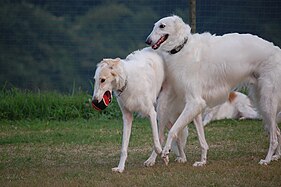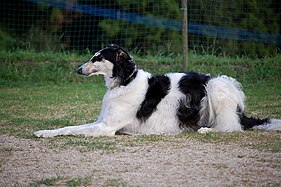Borzoi
| Borzoi | |||||||||||||||||||||||||||
|---|---|---|---|---|---|---|---|---|---|---|---|---|---|---|---|---|---|---|---|---|---|---|---|---|---|---|---|
 | |||||||||||||||||||||||||||
| Other names |
| ||||||||||||||||||||||||||
| Origin | Russia | ||||||||||||||||||||||||||
| |||||||||||||||||||||||||||
| |||||||||||||||||||||||||||
| Dog (domestic dog) | |||||||||||||||||||||||||||
The Borzoi[a] or Russian Hunting Sighthound[b] is a Russian breed of hunting dog of sighthound type. It was formerly used for wolf hunting,[1]: 125 and until 1936 was known as the Russian Wolfhound.[1]: 130 [3]
Etymology
[edit]The system by which Russians over the ages named their sighthounds was a series of descriptive terms rather than actual names. Borzoi is the masculine singular form of an archaic Russian adjective that means 'fast'. Borzaya sobaka ('fast dog') is the basic term for sighthounds used by Russians, though sobaka is usually dropped. The name psovaya derived from the word psovina, which means 'wavy, silky coat', just as hortaya (as in hortaya borzaya) means shorthaired. In modern Russian, the breed commonly called the Borzoi is officially known as russkaya psovaya borzaya. Other Russian sighthound breeds are stepnaya borzaya (from the steppe), called stepnoi; and krimskaya borzaya (from the Crimea), called krimskoi.[4][failed verification]
History
[edit]The Borzoi originated in the sixteenth century Russia by crossing Saluki and European sighthounds with thick-coated Russian breeds.[5][6]
The Borzoi was popular with the Tsars before the 1917 revolution. For centuries, Borzois could not be purchased but only given as gifts from the Tsar. Grand Duke Nicholas Nicolaievich of Russia bred countless Borzoi at Perchino, his private estate.[7]: 10 [8]
The Russkaya Psovaya Borzaya was definitively accepted by the Fédération Cynologique Internationale in 1956.[9]
-
Borzoi owned by Max Hartenstein, Berlin, Germany, 1879
-
Borzo by a Chair (St George Hare, 19th century)
-
Wolf hunting with borzois (1904), Efim A. Tikhmenev
-
Sarah Bernhardt, portrait by Georges Clairin
Description
[edit]Appearance
[edit]Borzois are large Russian sighthounds that resemble some central Asian breeds such as the Afghan hound, Saluki, and the Kyrgyz Taigan. Borzois come in a variety of colours.[10] The Borzoi coat is silky and flat, often wavy or slightly curly. The long top-coat is quite flat, with varying degrees of waviness or curling. The soft undercoat thickens during winter or in cold climates, but is shed in hot weather to prevent overheating. In its texture and distribution over the body, the Borzoi coat is unique. There should be a frill on its neck, as well as feathering on its hindquarters and tail.[11][12]
Temperament
[edit]The Borzoi is an affectionate and athletic breed of dog with a calm temperament.[13]
In terms of obedience, Borzois are selective learners who quickly become bored with repetitive, apparently pointless activity, and they can be very stubborn when they are not properly motivated. For example, food rewards, or "baiting", may work well for some individuals, but not at all for others. Nevertheless, Borzois are definitely capable of enjoying and performing well in competitive obedience and agility trials with the right kind of training.[7]: 113 [14][15]
Coat gallery
[edit]- Coat colours
-
Red
-
Black
-
White and yellow-and-white
-
Red and white
-
Black and white
-
White and brown
-
White and grey
-
White and sandy
Health
[edit]A 2024 UK study found an average life expectancy of 12 years for Borzois, with a sample size of 43, compared to 12.7 for purebreds and 12 for mongrels.[16]
An American study looking at echocardiographs of clinically healthy Borzoi found 53.8% to have heart murmurs, 30.2% to have trace or mild mitral regurgitation, 36.1% to have mild tricuspid regurgitation, and 14.4% to have cardiac disease.[17]
Notes
[edit]References
[edit]- ^ a b c Kim Dennis-Bryan (2020 [2012]). The Complete Dog Breed Book, second edition. London: Dorling Kindersley. ISBN 978-0-241-41273-2.
- ^ a b FCI-Standard N° 193: Russkaya Psovaya Borzaya (Borzoi – Russian Hunting Sighthound). Fédération Cynologique Internationale. Accessed June 2022.
- ^ Sabaneev, L.P. (1993). Hunting dogs: borzois and hounds (in Russian). Moscow: Terra Publishing. p. 571. ISBN 5-85255-188-0.
- ^ Сабанеев, Леонид (2 December 2021). Собаки охотничьи. Борзые и гончие (in Russian). Litres. ISBN 978-5-04-333011-6.
- ^ "Borzoi | Breeds A to Z | The Kennel Club". www.thekennelclub.org.uk. Retrieved 29 April 2022.
- ^ Martin, Nellie (2005). Borzoi – The Russian Wolfhound. Its History, Breeding, Exhibiting and Care. Vintage Dog Books. ISBN 1-84664-042-3.
- ^ a b Desiree Scott (2002). Borzoi. Dorking, Surrey: Interpet Publishing. ISBN 978-1-903098-93-6.
- ^ Kalamaras, G. (2019). "For All the Russian Wolfhounds—the Borzoi—Slaughtered During the Revolution, 1917". Undocumented: 156–157. doi:10.14321/J.CTVJSF4HW.90. ISBN 978-1-60917-587-0. S2CID 198844826.
- ^ FCI breeds nomenclature: Russkaya Psovaya Borzaya. Fédération Cynologique Internationale. Accessed June 2022.
- ^ "Borzoi Colors and Markings". American Kennel Club. Retrieved 19 March 2012.
- ^ "The Borzoi Standard". Borzoi Club of America. Archived from the original on 7 March 2012. Retrieved 19 March 2012.
- ^ Mischiha O. "Russian Borzoi". My Friend: The Dog. 2013: №1: 10–17.
- ^ "Borzoi". American Kennel Club. Retrieved 29 November 2018.
- ^ "Borzoi Club of America, Inc". Borzoiclubofamerica.org. Archived from the original on 29 February 2012. Retrieved 23 May 2012.
- ^ М, Венцеславский А. (14 March 2013). Псовая охота вообще (in Russian). Directmedia. ISBN 978-5-4460-1839-0.
- ^ McMillan, Kirsten M.; Bielby, Jon; Williams, Carys L.; Upjohn, Melissa M.; Casey, Rachel A.; Christley, Robert M. (1 February 2024). "Longevity of companion dog breeds: those at risk from early death". Scientific Reports. 14 (1). Springer Science and Business Media LLC: 531. Bibcode:2024NatSR..14..531M. doi:10.1038/s41598-023-50458-w. ISSN 2045-2322. PMC 10834484. PMID 38302530.
- ^ Sonya Wesselowski, K. Tess Sykes, Ashley B. Saunders, Stephen R. Werre (2024). Echocardiographic values and prevalence of cardiac abnormalities in clinically healthy adult Borzoi dogs. American Journal of Veterinary Research. 1.aop (2024): 1–10. doi:10.2460/ajvr.23.11.0255.
- ^ A.M. Macdonald (editor) (1972). Chambers Twentieth Century Dictionary. London: Chambers. ISBN 0-550-10206-X
- ^ "theborzoiclub.org.uk". theborzoiclub.org.uk. Retrieved 26 April 2014.
- ^ "Borzoi". Dictionary. Retrieved 26 April 2014.
- ^ "Definition of Borzoi in Oxford dictionary (British & World English)". Oxford dictionary. Archived from the original on 24 December 2013. Retrieved 26 April 2014.
Further reading
[edit]- Chadwick, Winifred E. (1952). The Borzoi Handbook. London: Nicholson & Watson. Including a translation of The Perchino Hunt by His Excellency Dmitri Walzoff (1912).
- Martin, Nellie L. (2005). Borzoi—The Russian Wolfhound: Its History, Breeding, Exhibiting and Care. Read Books. ISBN 978-1-84664-042-1.
- McRae, Gail C. (1989). Borzoi (New ed.). TFH Publications. ISBN 978-0-86622-676-9.
- Savenkova, V. (2003). Russkaya Psovaya Borzaya. Moscow. ISBN 978-5-17-016974-0.












